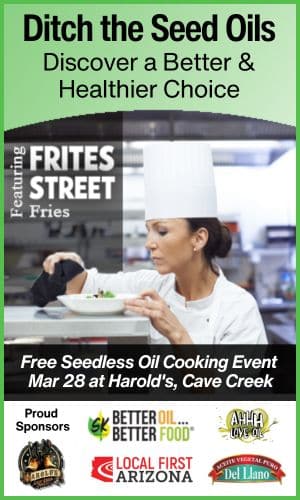
By Kirk Busch and Mark Goldstein
Imagine your city is so smart that sustainability is achieved at the highest level possible. Critical services such as water, transportation, electricity, communication, education, waste management, healthcare and emergency services were as efficient and convenient as real-time ride-sharing apps or same-day delivery from Amazon.
Work to make that a reality is currently under way by the State of Arizona, municipalities, universities, developers, and economic development and trade organizations.
According to Soren Kaplan, firms such as Verizon, AT&T, T-Mobile, Siemens and Panasonic are currently building out smart city infrastructure. Some of the key elements of Smart Cities include the following:
- Ubiquitous Wi-Fi & 5G—Availability of high-speed wireless internet anywhere and everywhere.
- Electric Vehicle Charging—Networks of charging stations that support the growth of electric vehicles.
- Connected Vehicle Infrastructure—Connected vehicles that “talk” to each other to prevent accidents.
- Smart, Sustainable Electricity—Data and information that give people the power to conserve and manage energy.
- Smart Street Lighting—Lighting that turns on or off based on the presence of vehicles and people.
- Smart Parking—Parking systems that keep traffic flowing.
- Interactive Signs—Displays and signs that provide information, directions and help when needed.
- Smart Water Systems—From leak detection to smart sprinkler systems to conserve and manage water.
- Smart Buildings—Smart heating and cooling, ventilation and lighting systems.
- Wilderness Cameras—Cameras in remote areas to detect and prevent fires, as well as aid search and rescue.
- Autonomous Electric Shuttles—Self-driving transportation services using carbon-free electric vehicles.
- Housing Solutions—Affordable, efficient, and sustainable housing for all citizens.
While technology enables much of what makes a city “smart,” such as sensors, data analytics, etc., the future really isn’t about technology as an end itself, but rather serving the needs of the various stakeholders that comprise a community. Using technology to solve social problems while improving quality of life is truly the definition of “smart.”
The Smart City Cloud Innovation Center
In January 2019, Arizona State University (ASU) launched the Smart City Cloud Innovation Center. It is powered by Amazon Web Services (AWS), an initiative that focuses on building smarter communities in the Phoenix metropolitan area by using AWS Cloud to solve pressing community and regional challenges.
ASU is the size of a small city, with more than 175K people, including students, faculty, staff, visitors and contractors, on the ASU network at any one time. ASU has become a “Living Lab” for smart city technology development and deployment.
ASU is the home of Julie Ann Wrigley Global Institute of Sustainability, The Rob and Melani Walton Sustainability Solutions Service Institute, and manages the largest distributed solar power system (40-plus megawatts) of any American university. ASU was also named the most innovative school four years in a row by U.S. News & World Report.
A Smart City in Development
Microsoft Co-founder Bill Gates purchased just over half interest in the investment of nearly $80 million for 25,000 acres west of the White Tank Mountains, according to the Arizona Commerce Authority.
The plan for the land is development of a “smart city.” A smart city comes alive when information and communication technology tap into the Internet of Things (IoT) to link components ranging from those that control the transportation and energy infrastructure down to the devices that can help doctors monitor their patients’ health.
The Belmont
The smart city (currently known as Belmont) will be comparable in square miles and projected population to Tempe. The National League of Cities published that 66% of U.S. cities currently have investments in smart city technology and initiatives, while a quarter of the remaining cities are exploring implementing some type of smart city application.
Belmont will create “a forward-thinking community with a communication and infrastructure spine that embraces cutting-edge technology, designed around high-speed digital networks (5G), data centers, new manufacturing technologies and distribution models, autonomous vehicles and autonomous logistics hubs,” according to the release.
Of the 25,000 acres, 3,800 acres is earmarked for development of office, retail and commercial space. Another 470 acres will be used for public schools, with the balance creating 80,000 residential units.
There are amazing times ahead as thoughtful, gifted visionaries collaborate to solve the modern-day challenges of society. In the spring of 2020, the Arizona Datacenter & Smart City Infrastructure Summit (#AzDC20) will host many of these visionaries to facilitate this critical agenda.
Kirk Busch is the CEO of BigData Southwest and Chairman of Az4Solar.Org. He has over 25 years of experience in the Global Semiconductor Industry. For the last decade, he has focused on economic development in the energy and data center industries. Busch currently serves on the Board of AzSTEM & Arizona Energy Consortium.
Mark Goldstein is president of the International Research Center, providing consulting, custom research, and strategic support for business, legal and public policy clients across a variety of disciplines and technology arenas since 1992. He serves on the board and executive committee of both the Arizona Technology Council and Arizona Telecommunications and Information Council, as well as is involved with a number of other policy, economic development, professional and trade groups.







I prefer a quiet small town and wildlife. Wildlife will be decimated by all this building. I hate every bit of it.
Small towns are great! It’s important to keep them thriving too.
What about jobs that train? I need a job. Been out of the loop for 13 years. Starting over single with a daughter and cost of homes?